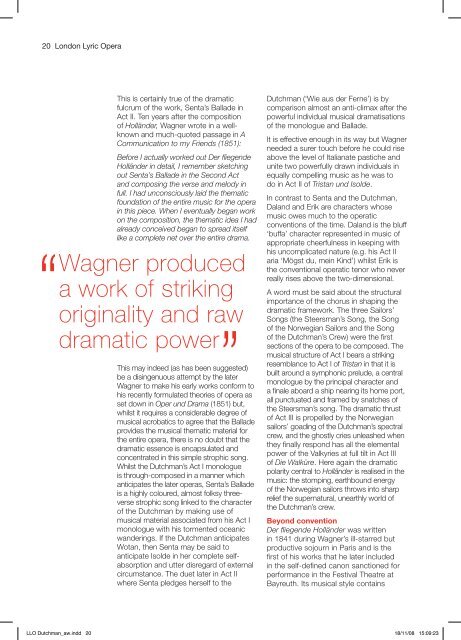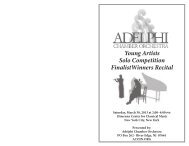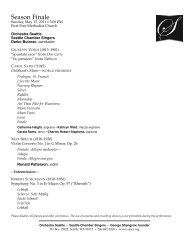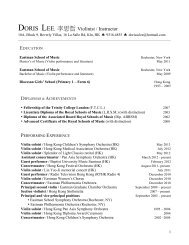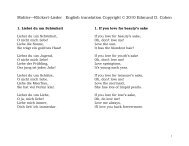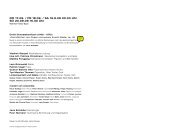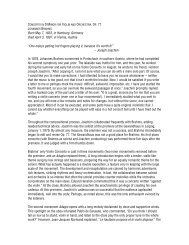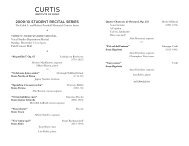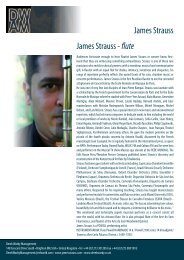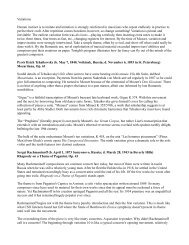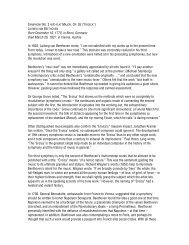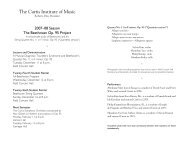Der fliegende Holländer - InstantEncore
Der fliegende Holländer - InstantEncore
Der fliegende Holländer - InstantEncore
You also want an ePaper? Increase the reach of your titles
YUMPU automatically turns print PDFs into web optimized ePapers that Google loves.
20 London Lyric Opera<br />
This is certainly true of the dramatic<br />
fulcrum of the work, Senta’s Ballade in<br />
Act II. Ten years after the composition<br />
of <strong>Holländer</strong>, Wagner wrote in a wellknown<br />
and much-quoted passage in A<br />
Communication to my Friends (1851):<br />
Before I actually worked out <strong>Der</strong> <strong>fliegende</strong><br />
<strong>Holländer</strong> in detail, I remember sketching<br />
out Senta’s Ballade in the Second Act<br />
and composing the verse and melody in<br />
full. I had unconsciously laid the thematic<br />
foundation of the entire music for the opera<br />
in this piece. When I eventually began work<br />
on the composition, the thematic idea I had<br />
already conceived began to spread itself<br />
like a complete net over the entire drama.<br />
Wagner produced<br />
a work of striking<br />
originality and raw<br />
dramatic power<br />
This may indeed (as has been suggested)<br />
be a disingenuous attempt by the later<br />
Wagner to make his early works conform to<br />
his recently formulated theories of opera as<br />
set down in Oper und Drama (1851) but,<br />
whilst it requires a considerable degree of<br />
musical acrobatics to agree that the Ballade<br />
provides the musical thematic material for<br />
the entire opera, there is no doubt that the<br />
dramatic essence is encapsulated and<br />
concentrated in this simple strophic song.<br />
Whilst the Dutchman’s Act I monologue<br />
is through-composed in a manner which<br />
anticipates the later operas, Senta’s Ballade<br />
is a highly coloured, almost folksy threeverse<br />
strophic song linked to the character<br />
of the Dutchman by making use of<br />
musical material associated from his Act I<br />
monologue with his tormented oceanic<br />
wanderings. If the Dutchman anticipates<br />
Wotan, then Senta may be said to<br />
anticipate Isolde in her complete selfabsorption<br />
and utter disregard of external<br />
circumstance. The duet later in Act II<br />
where Senta pledges herself to the<br />
Dutchman (‘Wie aus der Ferne’) is by<br />
comparison almost an anti-climax after the<br />
powerful individual musical dramatisations<br />
of the monologue and Ballade.<br />
It is effective enough in its way but Wagner<br />
needed a surer touch before he could rise<br />
above the level of Italianate pastiche and<br />
unite two powerfully drawn individuals in<br />
equally compelling music as he was to<br />
do in Act II of Tristan und Isolde.<br />
In contrast to Senta and the Dutchman,<br />
Daland and Erik are characters whose<br />
music owes much to the operatic<br />
conventions of the time. Daland is the bluff<br />
‘buffa’ character represented in music of<br />
appropriate cheerfulness in keeping with<br />
his uncomplicated nature (e.g. his Act II<br />
aria ‘Mögst du, mein Kind’) whilst Erik is<br />
the conventional operatic tenor who never<br />
really rises above the two-dimensional.<br />
A word must be said about the structural<br />
importance of the chorus in shaping the<br />
dramatic framework. The three Sailors’<br />
Songs (the Steersman’s Song, the Song<br />
of the Norwegian Sailors and the Song<br />
of the Dutchman’s Crew) were the first<br />
sections of the opera to be composed. The<br />
musical structure of Act I bears a striking<br />
resemblance to Act I of Tristan in that it is<br />
built around a symphonic prelude, a central<br />
monologue by the principal character and<br />
a finale aboard a ship nearing its home port,<br />
all punctuated and framed by snatches of<br />
the Steersman’s song. The dramatic thrust<br />
of Act III is propelled by the Norwegian<br />
sailors’ goading of the Dutchman’s spectral<br />
crew, and the ghostly cries unleashed when<br />
they finally respond has all the elemental<br />
power of the Valkyries at full tilt in Act III<br />
of Die Walküre. Here again the dramatic<br />
polarity central to <strong>Holländer</strong> is realised in the<br />
music: the stomping, earthbound energy<br />
of the Norwegian sailors throws into sharp<br />
relief the supernatural, unearthly world of<br />
the Dutchman’s crew.<br />
Beyond convention<br />
<strong>Der</strong> <strong>fliegende</strong> <strong>Holländer</strong> was written<br />
in 1841 during Wagner’s ill-starred but<br />
productive sojourn in Paris and is the<br />
first of his works that he later included<br />
in the self-defined canon sanctioned for<br />
performance in the Festival Theatre at<br />
Bayreuth. Its musical style contains<br />
LLO Dutchman_aw.indd 20 18/11/08 15:09:23


